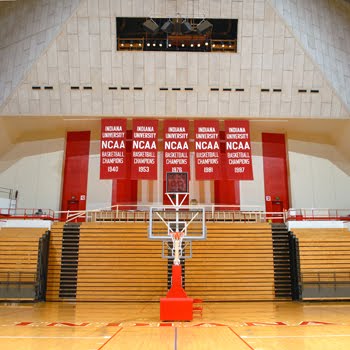Of course Florida and South Florida in particular is a character in the emerging tax scandal involving Swiss banking giant UBS and billions of undeclared greenback$.
Why should this story be any different from so many dozens of crazy stories before it over the past thirty years?
(See: Sen. Levin: Shut Down Giant Swiss Bank UBS,
Investigation Reveals Secrecy Tricks Allegedly Used by Swiss Bankers
By BRIAN ROSS, AVNI PATEL, and RHONDA SCHWARTZ, July 17, 2008
http://abcnews.go.com/Blotter/story?id=5394214&page=1 )
It's really great that the Art Basel Art Fair could help facilitate the meet-and-greet card exchanges that led directly to illicit behavior and financial transactions among the monied class.
Friendly, competent help like that down here is VERY hard to find, as we all know from experience.
No wonder UBS kept coming back year-after-year!
As of this morning, the UBS logo still appears in the bottom left of the Art Basel web page
http://www.artbasel.com/
FYI: Art 40 Basel takes place June 10-14, 2009.
In a few years, when they eventually make a feature film out of Tom Wolfe's upcoming novel on the Miami area, I hope they at least do some on-site shooting down here so that some good can come from all the (temporary?) ill-gotten gains.
(Who knows, maybe MIA's construction will even be finished by then!)
Regardless of how old the cool as a cucumber Swiss banker Bradley Birkenfeld really is, I hereby nominate Jeremy Irons to play him. http://www.imdb.com/name/nm0000460/
I can already see him in the role, stepping out of a long dark Town Car at night, impeccably dressed with a tan and saying bon mots to folks who love nothing in the world so much as cultured and erudite people tossing bon mots their way.
A little bit of Reversal of Evidence http://www.imdb.com/title/tt0100486/ and a little bit of Damage http://www.imdb.com/title/tt0104237/ and pretty soon you're talking Swiss banker
with dollar signs in his eyes as he hands out UBS cards with the three keys on it.
Ironically, I'm doing this post while simultaneously watching Clark Gable and Lana Turner on Turner Classic Movies in 1941's Honky Tonk, http://www.imdb.com/title/tt0033726/ in which Gable plays -yes- a lovable but tough con man in the Old West.
Naturally, now that I say all these things about characters and actors, I see thru this http://www.msnbc.msn.com/id/22474914/ and this, http://nymag.com/daily/entertainment/2008/01/inside_tom_wolfes.html
that Wolfe's novel Back to the Blood already has identifiable characters, and, none of 'em are Swiss bankers with the savoir-faire to help those with the dough avoid the tax man.
Maybe I'll have to be the one write that screenplay after all!
Herewith, the Swiss variation of a con, except here, rich folks are the easy marks, eager to escape paying Uncle Sam their fair share of the tax load while indulging their haute culture in South Florida.
And remember, as the Herald keeps insisting we must, they're not all snobs, they're just
connoisseurs and possible condo-owners to be.
Meanwhile, back in The Miami Art District...
(Numbers in blue identify footnote numbers)
from page 3/114:
On June 30, 2008, the United States took another step. It filed a petition in the U.S. District Court for the Southern District of Florida requesting leave to file an IRS administrative summons with UBS asking the bank to disclose the names of all of its U.S. clients who have opened accounts in Switzerland, but for which the bank has not filed forms with the IRS disclosing the Swiss accounts.10 The court approved service of the summons on UBS on July 1,
2008.11 The summons has apparently been served, but according to Swiss authorities the Swiss
and American governments are negotiating over its execution.12 This John Doe summons
represents the first time that the United States has attempted to pierce Swiss bank secrecy by
compelling a Swiss bank to name its U.S. clients.
from page 6-7/114
In May 2008, a second international tax scandal broke when the United States arrested a
private banker formerly employed by UBS AG, one of the largest banks in the world, on charges
of having conspired with a U.S. citizen and a business associate to defraud the IRS of $7.2
million in taxes owed on $200 million of assets hidden in offshore accounts in Switzerland and
Liechtenstein. The United States had earlier detained as a material witness in that prosecution a
senior UBS private banking official from Switzerland traveling on business in Florida, allegedly
seizing his computer and other evidence. In June 2008, the former UBS private banker, Bradley Birkenfeld, pleaded guilty to conspiracy to defraud the IRS.8 His alleged co-conspirator, Mario
Staggl, part owner of a trust company, remains at large in Liechtenstein. The current UBS senior private banking official, Martin Liechti, remains under travel restrictions. This enforcement
action appears to represent the first time that the United States has criminally prosecuted a Swiss banker for helping a U.S. taxpayer evade payment of U.S. taxes.9
On June 30, 2008, the United States took another step. It filed a petition in the U.S. District Court for the Southern District of Florida requesting leave to file an IRS administrative
summons with UBS asking the bank to disclose the names of all of its U.S. clients who have
opened accounts in Switzerland, but for which the bank has not filed forms with the IRS disclosing the Swiss accounts.10 The court approved service of the summons on UBS on July 1,
2008.11 The summons has apparently been served, but according to Swiss authorities the Swiss
and American governments are negotiating over its execution.12 This John Doe summons
represents the first time that the United States has attempted to pierce Swiss bank secrecy by
compelling a Swiss bank to name its U.S. clients.
from page 9/114
Marsh Accounts: Hiding $49 Million Over Twenty Years. James Albright Marsh, a U.S. citizen from Florida in the construction business, formed four Liechtenstein foundations, two in 1985, one in 1998, and one in 2004, and transferred substantial sums to them. LGT assisted him in establishing the two 1985 foundations, using documents that gave Mr. Marsh and his sons substantial control over the foundations and strong secrecy protections. By 2007, the assets in his four foundations had a combined value of more than $49 million. Although LGT became a participant in the QI Program in 2001, which requires foreign banks to report information on accounts with U.S. securities, LGT did not report the Marsh accounts. Instead it advised Mr. Marsh to divest his LGT foundations of U.S. securities, and treated the accounts as owned by non-U.S. persons, the Liechtenstein foundations that LGT had formed. After Mr. Marsh’s death in 2006, the IRS apparently discovered the Liechtenstein foundations through the documents released by the former LGT employee. Mr. Marsh’s family is now in negotiation with the IRS over back taxes, interest and penalties owed on the $49 million in undeclared assets.
from page 16/114:
Mr. Birkenfeld testified that UBS also provided its Swiss bankers with tickets and funds to go to events attended by wealthy U.S. individuals, so that they could solicit new business for the bank in Switzerland. He said that UBS sponsored U.S. events likely to attract wealthy clients, such as the Art Basel Air Fair in Miami; performances in major U.S. cities by the UBS Vervier Orchestra featuring talented young musicians; and U.S. yachting events attended by the elite Swiss yachting team, Alinghi, which was also sponsored by UBS. A UBS document laying out marketing strategies to attract U.S. clients confirms that the bank “organized VIP events” and engaged in the “Sponsorship of Major Events” such as “Golf, Tennis Tournaments, Art, Special Events.” This document even identified the 25 most affluent housing areas in the United States to provide “targeted locations where to organize events.”
page 19/114
Olenicoff Accounts. These concerns are further illustrated by the recent criminal prosecution involving UBS accounts opened in Switzerland by Mr. Birkenfeld for Igor Olenicoff. Mr. Olenicoff is a billionaire real estate developer, U.S. citizen, and resident of Florida and California. From 2001 until 2005, Mr. Birkenfeld and Mario Staggl, a trust officer from Liechtenstein helped Mr. Olenicoff open multiple bank accounts in the names of offshore companies he controlled at UBS in Switzerland and Neue Bank in Liechtenstein. For a time, Mr. Olenicoff was Mr. Birkenfeld’s largest private banking client. To service these accounts, Mr. Birkenfeld met with Mr. Olenicoff in the United States and elsewhere, communicated with him by telephone, fax, and email in the United States, and advised him on how to avoid disclosure of his accounts and assets to the IRS. In 2007, Mr. Olenicoff pled guilty to one criminal count of filing a false income tax return by failing to disclose the foreign bank accounts he controlled. He was sentenced to two years probation and 120 hours of community service, and paid six years of back taxes, interest, and penalties totaling $52 million. In 2008, Mr. Birkenfeld pled guilty to conspiring with Mr. Olenicoff to defraud the IRS and avoid payment of taxes owed on $200 million in assets hidden in accounts in Switzerland and Liechtenstein. Their alleged coconspirator, Mr. Staggl, remains at large in Liechtenstein.
page 42/114 one of the most fascinating parts of the story!
(1) Marsh Accounts: Hiding $49 Million Over Twenty Years
James Albright Marsh, Jr. (“Mr. Marsh”) is a construction contractor who lived in Florida with his wife and six children, until he died in 2006.117 He, his wife, and his children have always been U.S. citizens. In 1985, Mr. Marsh traveled to Liechtenstein, and LGT helped him establish two Liechtenstein foundations, the Chateau Foundation and Lincol Foundation, which then opened accounts at LGT Bank. Also during the 1980s, Mr. Marsh formed two more
Liechtenstein foundations, called Topanga Foundation118 and Largella Foundation,119 apparently using two other financial institutions in Liechtenstein.120 Over the years, these four
Liechtenstein foundations opened accounts at five Liechtenstein banks.121 By 2007, the
Liechtenstein accounts had assets with a combined value in excess of $49 million.122
This section on Mr. Marsh continues for five pages with all sorts of secretive legal corporate tactics they employed to keep below the radar.
from page 79-81/114
Using Transfer Corporations to “Cover Up the Tracks” of Client Funds. As indicated in some of the case histories described earlier, LGT documents obtained by the Subcommittee show that it was not uncommon for LGT to set up intermediary, pass-through corporations that were used by the bank, in the words of an LGT employee, “to cover up the tracks” of funds moving into LGT client accounts. When asked about these corporations, the head of compliance Officer for LGT Group confirmed their existence, explaining that these “auxiliary services corporations” served several functions, including the transmission of funds “confidentially.”338
The documents show that LGT used BTS Management Ltd., formed in the British Virgin Islands (BVI), to establish a number of the transfer corporations. The documents indicate that LGT typically asked BTS Management to form a BVI corporation which then opened an account at LGT or another bank, such as Bank du Gothard in Luxembourg. The transfer corporation then
received funds or securities from an LGT client and immediately transferred those funds or
securities to LGT, if its account was at an outside bank. In some instances the transfer corporation was then dissolved; in other instances, it continued in existence. Once the funds or
securities were delivered to LGT bank, they were moved internally within the bank, using a
mechanism called “journaling” to transfer them from one LGT account to another, here from the transfer corporation’s LGT account to the client’s LGT account. This internal transfer mechanism makes it much more difficult to trace the movement of funds and securities, since it
leaves no record outside of the bank showing that the assets were transferred to the ultimate
recipient, the LGT client.
The Subcommittee investigation uncovered several examples of LGT engaging in this practice. For example, Sera Financial Corporation is a BVI corporation that appears to have functioned as an LGT transfer corporation. An internal LGT document describes Sera Financial as a “[s]pecial purpose company (indirect subsidiary of LTV) for portfolio transfers for assets which are to be brought into an LTV structure.”339 The document shows, by account number, that Sera Financial held one account at Banque du Gothard and eleven separate accounts at LGT Bank in Liechtenstein.340 The document explains this unusual account structure as follows:
For each customer, a sub-account or deposit facility is opened under a reference at BdG
[Banque du Gothard] and at LGT …. Funds transfers as well as securities deliveries to BdG are in favor of SERA …. BdG is instructed to forward cash values and securities without delay to LGT BIL [Bank in Liechtenstein] in favor of Sera Financial Corp. with specification of the reference. ... As soon as the assets are credited at BIL, they are transferred to the destination account ….341
One example of how Sera Financial was used involves a new trust set up for a U.S. client in 2000. A LGT memorandum to the file discussing the transfer of assets to the new trust states:
“The trust shall open an account in the LGT Bank in Liechtenstein. The transfer of assets should
take place using this account. To cover up the tracks from UBS Zurich to the trust in Liechtenstein, I recommend an intermediary Single Purpose Company.”342 LGT decided to use
Sera Financial as the transfer corporation. A wire transfer instruction from Gotthard Bank shows how the transfer operation worked.343 It shows that on October 31, 2000, after $1.2 million had been credited to the Sera Financial account at Banque du Gothard: “BTS Management Limited, Tortola, as Managing Director of the company Sera Financial Corporation, Tortola, B.V.I. [h]ereby declares: … that the following beneficiary(ies) is/are entitled to the above-referenced transaction,” naming the U.S. citizen from Florida, known to the Subcommittee as a U.S. client of LGT at that time. The $1.2 million was then transferred to his account.
pages 96-97/114
Mr. Birkenfeld testified that UBS not only authorized and paid for the business trips to the United States, but also provided the Swiss bankers with tickets and funds to go to events
attended by wealthy U.S. individuals, so that they could solicit new business for the bank in
Switzerland. He said that UBS sponsored U.S. events likely to attract wealthy clients, such as
the Art Basel Air Fair in Miami; performances in major U.S. cities by the UBS Vervier Orchestra
featuring talented young musicians; and U.S. yachting events attended by the elite Swiss
yachting team, Alinghi, which was also sponsored by UBS. An internal UBS document laying
out marketing strategies to attract U.S. and Canadian clients confirms that the bank “organized
VIP events” and engaged in the “Sponsorship of Major Events” such as “Golf, Tennis
Tournaments, Art, Special Events.”405 This document even identified the 25 most affluent
housing areas in the United States to provide “targeted locations where to organize events.”406
Mr. Birkenfeld described to the Subcommittee how Swiss private bankers used these events and other means to find new U.S. clients during their trips to the United States: You might go to sporting events. You might go to car shows, wine tastings. You might deal with real estate agents. You might deal with attorneys. … It’s really where do the rich people hang out, go and talk to them. … [I]t wasn’t difficult to walk into a party with a … business card, and then someone ask[s] you, ‘What do you do?’ and you say, ‘Well, I work for a bank in Switzerland, and we manage money there and open accounts.’
And people immediately would recognize, oh, this is someone who could open new
business by opening accounts.407
page 98/114
For example, the Subcommittee found that at least five UBS client advisors travelled to the United States for trips coinciding with the Art Basel Art Fair, an annual UBS-sponsored event held in early December in Miami Beach since 2002. The data shows that, over the years,
several UBS Swiss client advisors were in Miami during the art show, including three in 2007.
On the customs forms completed over the years by UBS travelers prior to landing at Miami
International airport, only one client advisor stated that the purpose of the trip was for business, while five described the visit as for pleasure. These client advisors’ trips, however, coincided
closely with the dates of the Art Basel event, including an invitation-only private showing.
Moreover, the Subcommittee’s analysis of the customs and travel records obtained from the
Department of Homeland Security show that a Swiss-based UBS client advisor traveled to New
England from June 20-25, 2004, a trip coinciding with the UBS Regatta Cup, held in Newport,
RI from June 19-26, 2004.
pages 105-106/114
(5) Violating Restrictions on U.S. Activities
The UBS practices just described, related to Swiss banker activities undertaken in the United States to recruit and service U.S. clients, may have violated U.S. law as well as UBS policy. As explained earlier, U.S. securities and banking laws prohibit non-U.S. persons from advertising securities services or products, executing securities transactions, or performing banking services within the United States, without an appropriate license. Moreover, U.S. tax laws may require a foreign financial institution to report to the IRS on 1099 Forms sales of non-U.S. securities effected in the United States, such as by executing a transaction by a broker physically in the United States or ordering the completion of a transaction through telephone calls or emails originating from the United States.
It was to avoid violating U.S. law, exceeding its licensed activities, or triggering 1099 reporting requirements, that caused UBS to issue policy statements restricting the activities that its non-U.S. bankers could undertake while in the United States. Its 2002 and 2004 policy statements, for example, prohibited UBS Swiss bankers, while in the United States, from advertising securities products to their clients, informing clients of how their security portfolios were performing, providing copies of account statements, or using U.S. mails, faxes, telephone calls or email to discuss a client’s securities portfolio.443 UBS also prohibited its Swiss bankers from prospecting for new clients while in the United States, soliciting new accounts, or obtaining
signatures on account opening documentation.
Despite these prohibitions, it appears that UBS Swiss bankers in the United States servicing U.S. clients routinely undertook actions that contravened the UBS restrictions. Mr. Birkenfeld described, for example, an art festival sponsored by UBS in Miami each year, which he attended with other Swiss bankers for the express purpose of soliciting new accounts. “We went to these events. We went to dinners, we went to art exhibitions, we went to private homes as private bankers, knowingly by management that they were paying for our hotel, paying for our airfare, paying us our salary, and getting us tickets to the UBS VIP tent to drink champagne with
clients.”444 He testified that he witnessed Swiss bankers soliciting new accounts and completing
account opening documentation while in the United States. He testified that in some cases,
“instead of saying, ‘I signed it in New York,’ they brought the forms back to Geneva and they
put in ‘Geneva.’”445 When asked whether he had promoted securities products during his trips to the United States, he responded, “We were promoting anything.”446
Mr. Birkenfeld also told the Subcommittee that UBS Swiss bankers routinely communicated with their U.S. clients about the status of their accounts, including their securities portfolios. He said that some Swiss private bankers communicated with their U.S. clients by telephone or fax, or by sending occasional documents to them in the United States by overnight mail.447 He said the bankers sometimes used code names during the telephone calls, so that the U.S. client would not have to identify themselves by name, in case anyone was listening.448 He said that U.S. clients generally did not like sending or receiving emails via computer, “because they didn’t want that link, for obvious reasons.”449 Nevertheless, some clients did use email, as shown in the case involving Mr. Birkenfeld and Mr. Olenicoff, examined further below. Mr. Birkenfeld also described how Swiss bankers brought into the United States information about clients’ accounts and securities portfolios. He told the Subcommittee that his day-to-day interactions with clients were in direct contradiction to the restrictions set out in UBS’ policy statements. He indicated those policies simply were not enforced while he was at the bank.450
from page 108/114
Contrary to this representation by UBS, however, a Subcommittee review of the relevant
travel data for the Swiss bankers determined that, from January to April 2008, UBS client
advisors made twelve trips to the United States, travelling from Switzerland to New York,
Miami, San Francisco, and Las Vegas. The Customs I-94 Forms indicate that, on half of these
trips, the Swiss bankers indicated they were travelling for business purposes, while on the other
half, the Swiss bankers indicated they were travelling to the United States for non-business
purposes. With respect to Mr. Liechti, head of the UBS Wealth Management Americas division,
the I-94 Form shows that he arrived in the United States on April 20, 2008, on business. There is no record of his departure to date.
The clear contrast between the UBS policy restrictions dating back to at least 2002, and the activities undertaken by UBS Swiss bankers while traveling in the United States, as described
by Mr. Birkenfeld in his deposition, in connection with his recent indictment, and in internal UBS documents, suggests that until recently, the UBS restrictions were not being enforced. This lack of enforcement, in turn, raises concerns that UBS Swiss bankers with U.S. clients may have been routinely violating not only the bank’s internal policies, but also U.S. law. UBS is currently under investigation by the SEC, IRS, and Department of Justice regarding the activities of its Swiss bankers in the United States.
And in the end...
D. Analysis
Unlike LGT, UBS did not generally refrain from conducting banking operations within the
United States. UBS Swiss bankers targeted U.S. clients, traveled across the country in search of
wealthy individuals, and aggressively marketed their services to U.S. taxpayers who might
otherwise never have opened Swiss accounts. UBS practices resulted in its U.S. clients
maintaining undeclared Swiss accounts that collectively held billions of dollars in assets that
were not disclosed to the IRS. UBS serviced these accounts, in part, by offering banking and
securities products and services within the United States that UBS Swiss bankers were not
licensed to provide. Swiss bank secrecy laws hid not only the misconduct of U.S. taxpayers
hiding assets at UBS in Switzerland, but also the actions taken by UBS bankers to assist those
U.S. clients.
UBS has now stopped all travel by its Swiss bankers to the United States, issued more
restrictive policies, and is conducting an internal review to gauge the nature and extent of the
problem. UBS also cooperated with this Subcommittee in its efforts to gain a full understanding
of the facts and issues.
____________________________________________________
from the
U.S. SENATE PERMANENT SUBCOMMITTEE ON INVESTIGATIONS, STAFF REPORT ON TAX HAVEN BANKS AND U.S. TAX COMPLIANCE, July 17, 2008
at:
http://abcnews.go.com/images/Blotter/REPORT-Tax%20Haven%20Banks%20(July%2017%2008).pdf
Friday, July 18, 2008
Miami's Art Basel's Role in the UBS (Tax Cheat) Scandal
Subscribe to:
Comments (Atom)
In the Heart of a Great Country, Beats the Soul of Hoosier Nation
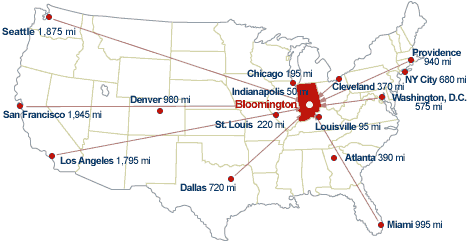
"In the Heart of a Great Country, Beats the Soul of Hoosier Nation." -South Beach Hoosier, 2007
#IUBB, #bannersix
The South Florida I Grew Up In
Excerpts from Joan Didion's Miami, 1987, Simon & Schuster:
In the continuing opera still called, even by Cubans who have now lived the largest part of their lives in this country, el exilo, the exile, meetings at private homes in Miami Beach are seen to have consequences. The actions of individuals are seen to affect events directly. Revolutions and counter-revolutions are framed in the private sector, and the state security apparatus exists exclusively to be enlisted by one or another private player. That this particular political style, indigenous to the Caribbean and to Central America, has now been naturalized in the United States is one reason why, on the flat coastal swamps of South Florida, where the palmettos once blew over the detritus of a dozen failed booms and the hotels were boarded up six months a year, there has evolved since the early New Year's morning in 1959 when Fulgencio Batista flew for the last time out of Havana a settlement of considerable interest, not exactly an American city as American cities have until recently been understood but a tropical capital: long on rumor, short on memory, overbuilt on the chimera of runaway money and referring not to New York or Boston or Los Angeles or Atlanta but to Caracas and Mexico, to Havana and to Bogota and to Paris and Madrid. Of American cities Miami has since 1959 connected only to Washington, which is the peculiarity of both places, and increasingly the warp...
"The general wildness, the eternal labyrinths of waters and marshes, interlocked and apparently neverending; the whole surrounded by interminable swamps... Here I am then in the Floridas, thought I," John James Audobon wrote to the editor of The Monthly American Journal of Geology and Natural Science during the course of an 1831 foray in the territory then still called the Floridas. The place came first, and to touch down there is to begin to understand why at least six administations now have found South Florida so fecund a colony. I never passed through security for a flight to Miami without experiencing a certain weightlessness, the heightened wariness of having left the developed world for a more fluid atmosphere, one in which the native distrust of extreme possibilities that tended to ground the temperate United States in an obeisance to democratic institutions seemed rooted, if at all, only shallowly.
At the gate for such flights the preferred language was already Spanish. Delays were explained by weather in Panama. The very names of the scheduled destinations suggested a world in which many evangelical inclinations had historically been accomodated, many yearnings toward empire indulged...
In this mood Miami seemed not a city at all but a tale, a romance of the tropics, a kind of waking dream in which any possibility could and would be accomodated...
Hallandale Beach Blog
http://www.hallandalebeachblog.blogspot.com/
Hallandale Beach Blog is where I try to inject or otherwise superimpose a degree of accountability, transparency and much-needed insight onto local Broward County government and public policy issues, which I feel is sorely lacking in local media now, despite all the technological advances that have taken place since I grew-up in South Florida in the 1970's. On this blog, I concentrate my energy, enthusiasm, anger, disdain and laser-like attention primarily on the coastal cities of Aventura, Hollywood and Hallandale Beach.
IF you lived in this part of South Florida, you'd ALREADY be in stultifying traffic, be paying higher-than-necessary taxes, and be continually musing about the chronic lack of any real accountability or transparency among not only elected govt. officials, but also of City, County and State employees as well. Collectively, with a few rare exceptions, they couldn't be farther from the sort of strong results-oriented, work-ethic mentality that citizens here deserve and are paying for.
This is particularly true in the town I live in, the City of Hallandale Beach, just north of Aventura and south of Hollywood. There, the Perfect Storm of years of apathy, incompetency and cronyism are all too readily apparent.
It's a city with tremendous potential because of its terrific location and weather, yet its citizens have become numb to its outrages and screw-ups after years of the worst kind of chronic mismanagement and lack of foresight. On a daily basis, they wake up and see the same old problems again that have never being adequately resolved by the city in a logical and responsible fashion. Instead the city government either closes their eyes and hopes you'll forget the problem, or kicks them -once again- further down the road.
I used to ask myself, and not at all rhetorically, "Where are all the enterprising young reporters who want to show through their own hard work and enterprise, what REAL investigative reporting can produce?"
Hearing no response, I decided to start a blog that could do some of these things, taking the p.o.v. of a reasonable-but-skeptical person seeing the situation for the first time.
Someone who wanted questions answered in a honest and forthright fashion that citizens have the right to expect.
Hallandale Beach Blog intends to be a catalyst for positive change. http://www.hallandalebeachblog.blogspot.com/
http://www.hallandalebeachblog.blogspot.com/
Hallandale Beach Blog is where I try to inject or otherwise superimpose a degree of accountability, transparency and much-needed insight onto local Broward County government and public policy issues, which I feel is sorely lacking in local media now, despite all the technological advances that have taken place since I grew-up in South Florida in the 1970's. On this blog, I concentrate my energy, enthusiasm, anger, disdain and laser-like attention primarily on the coastal cities of Aventura, Hollywood and Hallandale Beach.
IF you lived in this part of South Florida, you'd ALREADY be in stultifying traffic, be paying higher-than-necessary taxes, and be continually musing about the chronic lack of any real accountability or transparency among not only elected govt. officials, but also of City, County and State employees as well. Collectively, with a few rare exceptions, they couldn't be farther from the sort of strong results-oriented, work-ethic mentality that citizens here deserve and are paying for.
This is particularly true in the town I live in, the City of Hallandale Beach, just north of Aventura and south of Hollywood. There, the Perfect Storm of years of apathy, incompetency and cronyism are all too readily apparent.
Sadly for its residents, Hallandale Beach is where even the easily-solved or entirely predictable quality-of-life problems are left to fester for YEARS on end, because of myopia, lack of common sense and the unsatisfactory management and coordination of resources and personnel.
It's a city with tremendous potential because of its terrific location and weather, yet its citizens have become numb to its outrages and screw-ups after years of the worst kind of chronic mismanagement and lack of foresight. On a daily basis, they wake up and see the same old problems again that have never being adequately resolved by the city in a logical and responsible fashion. Instead the city government either closes their eyes and hopes you'll forget the problem, or kicks them -once again- further down the road.
I used to ask myself, and not at all rhetorically, "Where are all the enterprising young reporters who want to show through their own hard work and enterprise, what REAL investigative reporting can produce?"
Hearing no response, I decided to start a blog that could do some of these things, taking the p.o.v. of a reasonable-but-skeptical person seeing the situation for the first time.
Someone who wanted questions answered in a honest and forthright fashion that citizens have the right to expect.
Hallandale Beach Blog intends to be a catalyst for positive change. http://www.hallandalebeachblog.blogspot.com/
Hallandale Beach's iconic beachball-colored Water Tower, between beach and A1A/South Ocean Drive
Hollywood in Cartoons, The New Yorker

"Gentlemen, I am happy to announce that as of today we are closing down our Washington news bureau and moving the entire operation to L.A."
Hollywood in Cartoons, The New Yorker

"O.K., so I dig a hole and put the bone in the hole. But what's my motivation for burying it?"
Hollywood in cartoons, 10-21-06 Non-Sequitur by Wiley, www-NON-SEQUITUR.COM

The Magic of Hollywood: A motion has been put forth that we should seek to create rather than imitate. All in favor of killing this silly notion, nod in mindless agreement...
Miami Dolphins
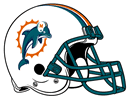
South Beach Hoosier's first Dolphin game at the Orange Bowl came in Dec. 1970, aged 9, a 45-3 win over Buffalo that propelled them into their first ever playoff appearance.
Sebastian the Ibis, the Spirited Mascot of the University of Miami Hurricanes

Before going to my first U-M game at the Orange Bowl in 1972, a friend's father often would bring me home an extra 'Canes game program. That's how I came to have the Alabama at U-M game program from Nov. 16, 1968, which was the first nationally-televised college football night game in color. (A 14-6 loss to the Crimson Tide.) After that first ballgame against Tulane, as l often did for Dolphin games if my father wasn't going, I'd get dropped off at the Levitz parking lot near the 836 & I-95 Cloverleaf in NMB, and catch a Dade County Park & Ride bus, going straight to the Orange Bowl. Onboard, I'd get next to the window and listen to WIOD's pre-game show on my Radio Shack transistor radio. A few times, I was just about the only person onboard besides the bus driver, which was alright by me. Once at the Orange Bowl, if I didn't already have a ticket, I'd buy a game program for myself and one or two for friends or teachers before heading to the ticket window, since you usually couldn't find a program vendor once inside. I probaly had a friend or my father with me for just under 40% of the U-M games I ever went to, but you have to remember that the team, though blessed with several talented players, like Chuck Foreman and Burgess Owens, was just so-so to average at best, and the games were usually played on Friday nights, so it wasn't exactly high on everyone's list of things to do. Depending upon the opponent, if I was alone, I'd often have entire areas of the Orange Bowl to myself. (Wish I had photos of that now!) For instance, I had a good portion of the East (open) End Zone to myself against Oklahoma in the mid-70's, when the Boomer Schooner and the Schooner Crew went out on the field after an Oklahoma TD, and the Schooner received an unsportsmanlike conduct penalty from the refs, as would happen years later in an Orangle Bowl Classic game. (Against FSU?) I was there for the wins and losses under Pete Elliott, Carl Selmer & Lou Saban, and the huge on-field fight in '73 when under eventual national champion Notre Dame (under Ara Parseghian), they called a time-out with less than a minute to go, and already up 37-0. Their rationale? To score another TD and impress the AP football writers; final score 44-0. Well, they got their wish and beat Alabama 24-23 for the title at the Sugar Bowl. A year later, thanks to my Mom's boss, she and I saw Ara's last game as head coach of the Irish in the Orange Bowl Game from the East End Zone -in front of the Alabama cheerleaders!!!- in an exciting 13-11 Notre Dame win over Alabama and Bear Bryant, a rematch of the '73 national title game. I was also present for the U-M's huge 20-15 win under Pete Elliott against Darrel Royal's Texas Longhorns, the week Sports Illustrated's College Football preview issue came out with Texas on the cover, below. I was also present for lots of wins against schools called College of the Pacific, UNLV and Cal-Poly San Luis Obsispo, which I'd then never heard of before.
Miami Dolphins Cheerleaders, April 28, 2007

Photo by Mario J. Bermudez. April 28, 2007 at Dolphins NFL Draft Party at Dolphin HQ, Davie, FL
Of cheerleaders past and present
Given South Florida's unique version of the melting pot -con salsa- demographics and mindset, these women in the photo above are surely what most South Floridians would consider attractive women. But for this observer, who's spent hours & hours at IU cheerleader tryouts and who has known dozens of cheerleaders -and wannabes- in North Miami Beach, Bloomington, Evanston and Washington, D.C., the whole time I was watching these members of the Dolphins' squad perform, I couldn't help but compare them and their routines to those of some IU friends of mine who ALWAYS showed true Hoosier spirit & enthusiasm.
Sitting at my table right near the stage and still later, while watching the long lines of Dolphin fans of all ages waiting to snap photos of themselves with the cheerleaders, I couldn't help but think about those friends who always left me and other Hoosier fans feeling positive & optimistic.
Was there anyone I saw in Davie who possessed these valuable intangibles: the dancing precision of IU Red Stepper -and Captain- Gail Amster, my talented and spirited Phi Beta Kappa pal from Deerfield (IL), who always sat next to me in our Telecom. classes as we took turns entertaining the other; the ebullient spirit & energy of two Hoosier cheerleaders -and captains- from Bloomington, Wendy (Mulholland) Moyle & Sara Cox; the hypnotic, Midwestern, girl-next-door sexiness of Hoosier cheerleader Julie Bymaster, from Brownsburg; or, the adorable Southern girl-next-door appeal of former Hoosier Pom squader Jennifer Grimes, of Louisville, always such a clear distraction while sitting underneath the basket?
Nope, not that I could see. But then they were VERY tough acts to follow!!!
And that's not to mention my talented & spirited friends like Denise Andrews of Portage, Jody Kosanovich of Hammond & Linda Ahlbrand of Chesterton, all of whom were dynamic cheerleaders -and captains- at very large Hoosier high schools that were always in the championship mix, with Denise's team winning the Ind. football championship her senior year when she was captain -just like in a movie. That Denise, Jody & Linda all lived on the same dorm floor, just three stories above me at Briscoe Quad our freshman year, was one of the greatest coincidences -and strokes of luck for me!- that I could've ever hoped for.
You could hardly ask for better ambassadors of IU than THESE very smart, sweet and talented women. In a future SBH post, I'll tell the story of one of the greatest Hoosiers I ever met, the aforementioned Wendy Mulholland, the Bloomington-born captain and emotional heart of the great early '80's IU cheerleading squads, and the daughter of Jack Mulholland, IU's former longtime Treasurer. The acorn doesn't fall far from a tree built on a foundation of integrity & community service!
(After he retired, Mr. Mulholland was the first executive director of the Community Foundation of Bloomington and Monroe County. I used to joke with Wendy that her dad's name was the one that was permanently affixed to the bottom of my work-study checks for years, while I worked at the Dept. of Political Science's Library, first, at the Student Building in the old part of campus, and then later, after it was refurbished, in magnificent Woodburn Hall, my favorite building on campus.)
In that future post, I'll share some reflections on Wendy's great strength of character and personality; my intentions of returning to Bloomington a few weeks before Fall '82 classes started, so I could help Wendy train and work-out to rehab her knee, so she'd feel confident in trying-out for the squad again, following a bad knee injury that'd left her physically-unable to try-out for the squad the previous spring, a big disappointment to those of us who cared about both Wendy and the team; my incredulity at, quite literally, running into Wendy while walking down a sidewalk one afternoon a few years later in Evanston, IL, when we were astonished to discover we were both living there, with me trying to hook on with a Windy City advertising agency, and Wendy then-attending Kellogg (KGSM) at Northwestern, right when the WSJ had named Kellogg the #1 Business School in the country.
I'll also share a story about Wendy performing a true act of kindness towards me in 1982, when I was having a real emergency, and she went above-and-beyond what I had any logical reason to expect. Yet, Wendy, along with her very helpful dad, Jack, came through for me when I was in a very bad time crunch. I've never forgotten Wendy's kindness towards me, and her true Hoosier spirit.
There's NOTHING I wouldn't do for Wendy Mulholland.
It's All About "The U"
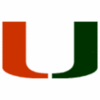
South Beach Hoosier's first U-M football game at the Orange Bowl was in 1972, age 11, against Tulane in the infamous "Fifth Down" game. In order to drum up support and attendance for the U-M at the Orange Bowl, that game had a promotion whereby South Florida kids who were school safety patrols could get in for free IF they wore their sash. I did. Clearly they knew that it was better to let kids in for free, knowing their parents would give them money to buy food and souvenirs, perhaps become a fan and want to return for future games. The ballgame made an interesting impression on The New York Times, resulting in this gem from the "View of Sport" column of Oct, 14, 1990, labeled 'Fifth Down or Not, It's Over When It's Over.' -"In 1972, aided by a fifth-down officiating gift in the last moments of the game, Miami of Florida defeated Tulane, 24-21. The country and the world was a much different place that fall because The New York Times took time and space to editorialize on the subject. ''Is it right for sportsmen, particularly young athletes, to be penalized or deprived of the goals for which they earnestly competed because responsible officials make mistakes? The ideal of true sportsmanship would be better served if Miami forfeited last week's game.' South Beach Hoosier hardly needs to tell you that this was YET another New York Times editoral that was completely ignored!
The issue I took with me the night of U-M's 20-15 upset of #1 Texas at the Orange Bowl
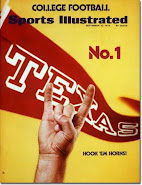
College Football, Texas No. 1, Hook 'em Horns, Sept. 10, 1973. Living in North Miami Beach in the '70's, my Sports Illustrated usually showed up in my mailbox on the Thursday or Friday before the Monday cover date. And was read cover-to-cover by Sunday morning.
The Perfect Storm

U-M QB Ken Dorsey, Miami Hurricanes Undefeated National Champions 2001, Jan. 2002
Miami's Romp in the Rose
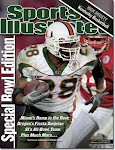
Miami running back Clinton Portis, Jan. 7, 2002
Why the University of Miami should drop football
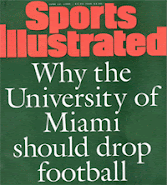
June 12, 1995
REVENGE!
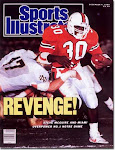
Steve McGuire and Miami Overpower No.1 Notre Dame, Dec. 4, 1989
How Sweet It Is!
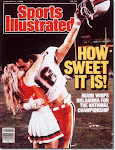
Miami Whips Oklahoma For The National Championship, Pictured: Dennis Kelleher, Jan. 11, 1988
My, Oh My, Miami!
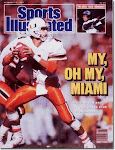
Steve Walsh and the Canes Stun FSU, Oct. 12, 1987
Why Is Miami No. 1?

QB Vinny Testaverde, Nov. 24, 1986
Miracle In Miami
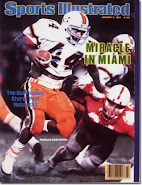
The Hurricanes Storm Past Nebraska, Halfback Keith Griffin, Jan. 9, 1984
Special Issue: College Football
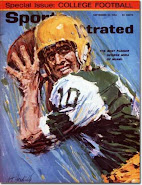
The Best Passer, George Mira of Miami, Sept. 23, 1963
1984 College & Pro Spectatcular
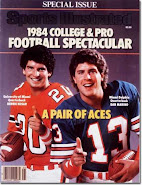
A Pair Of Aces: U-M QB Bernie Kosar & Miami Dolphin QB Dan Marino, Sept. 5, 1984
Pro Football Hall of Fame Special Issue

Dan Marino, Class of 2005, Aug. 2005
FACES OF THE NFL
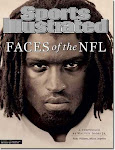
A Portfolio by Walter Iooss Jr., Ricky Williams, Miami Dolphins, Dec. 9, 2002
Coming Back
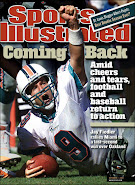
Jay Fiedler rallies Miami to a last-second win over Oakland, Oct. 1, 2001
Dan's Last Stand
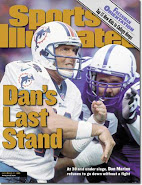
At 38 and under siege, Dan Marino refuses to go down without a fight, Dec. 13, 1999
The War Zone
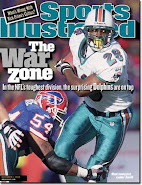
In the NFL's toughest division, the surprising Dolphins are on top, Lamar Smith, Dec. 11, 2000
Down and Dirty
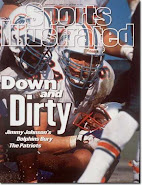
Jimmy Johnson's Dolphins Bury The Patriots, Steve Emtman, Sept. 9, 1996
The Sunshine Boys

Now Playing in Miami: The Dan Marino and Jimmy Johnson Show, May 11, 1996
HOT & NOT
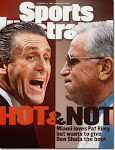
Miami loves Pat Riley but wants to give Don Shula the boot, Dec. 11, 1995
NFL PREVIEW 1995
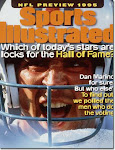
Which of today's stars are locks for the Hall of Fame? Dan Marino for sure. But who else? To find out, we polled the men who do the voting. Sept. 14, 1995
Sportsman Of The Year
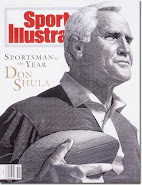
Don Shula, Dec. 20, 1993
Dan The Man
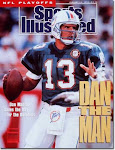
Dan Marino Saves The Day For The Dolphins, Jan. 14, 1991
Dangerous Dan
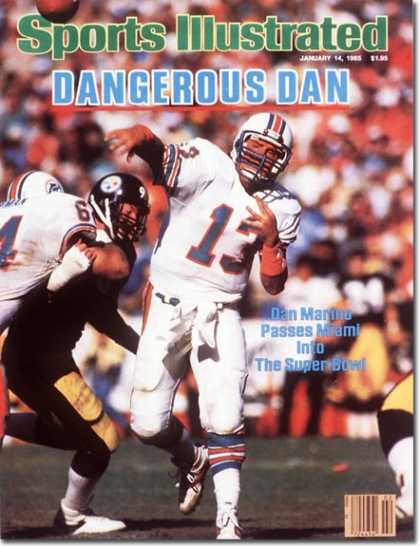
Dan Marino Passes Miami Into The Super Bowl, Jan. 14, 1985
Super Duper!

Wide Receiver Mark Duper Of The Undefeated Dolphins, Nov. 19, 1984
Air Raid! Miami Bombs Washington
+Sep+10,+1984.jpg)
Mark Clayton (burning Darryl Green) Sept. 10, 1984
Rookies On The Rise
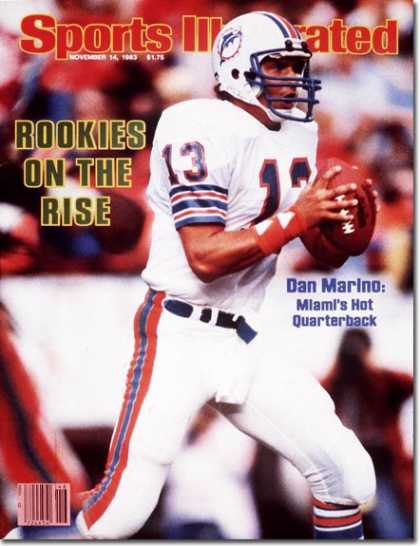
Dan Marino: Miami's Hot Quarterback, Nov. 14, 1983
New Life In The WFL
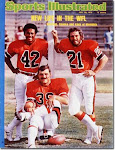
Warfield, Csonka and Kiick of Memphis, July 28, 1975
Zonk! Miami Massacres Minnesota
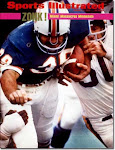
Larry Csonka, Jan. 21, 1974
Pro Football, Miami Is Rough And Ready
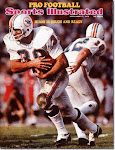
Larry Csonka & Bob Griese, Sept. 17, 1973
Miami All The Way
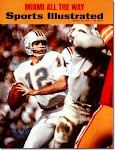
Bob Griese, Jan. 22, 1973
It's Miami and Washington
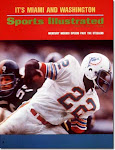
Mercury Morris Speeds Past The Steelers, Jan. 8, 1973
Kiick and Csonka, Miami's Dynamic Duo

Larry Csonka & Jim Kiick, Aug. 7, 1972
Sudden Death at Kansas City
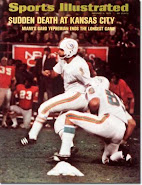
Miami's Garo Yepremian Ends the Longest Game; (kneeling) placekick holder Karl Noonan, Jan. 3, 1972
New Pro in a New Town

Miami's Frank Emanuel, Aug. 8, 1966
Old-style "Obie" the Orange Bowl Committee mascot

The iconic image I grew-up with in Miami, before FedEx got into the picture

